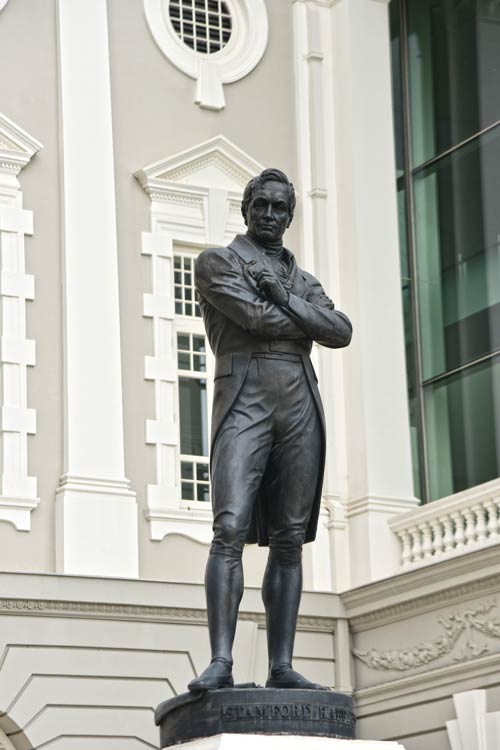
Two Centuries of British Rule of Law: A Look Back to 1819
As Singapore commemorates its bicentennial, we look back at the year 1819 when British law was first “introduced” into Singapore. The article argues that at the “founding” of modern Singapore, international law played a far larger role than the English common law, but that despite the lack of legal authority, Raffles nonetheless implemented a system of justice that was largely common law in its spirit.
British Law in the Straits Settlements
Although the East India Company (EIC) established its first trading posts in Southeast Asia in the early 17th century, it was not till 1786 that it established a more permanent presence with its acquisition of the Prince of Wales Island or Penang. Penang – which along with Singapore and Malacca later became part of the Straits Settlements – was placed under the Bengal Presidency in Calcutta.
As the settlement grew and flourished, it became necessary to put its administration of justice on a more stable footing and in 1800, the Governor-General in India appointed John Dickens as Judge and Magistrate of Penang. Unfortunately for Dickens, his appointment did not come along with legislation stipulating his powers and jurisdiction and it was not till 1807 that a Charter to establish a Court of Judicature was issued. The following year, the Court of Judicature of the Prince of Wales Island was established. The important thing to note about this development is the fact that the Letters Patent Establishing the Court of Judicature of Prince of Wales Island of 1807 (otherwise known as the First Charter of Justice) was modelled closely on the Indian Charter of 1774, but more of this later. The effect of this First Charter of Justice was to import English law into Penang.
Raffles’s Secret Mission
Throughout his life, Thomas Stamford Bingley Raffles (1781–1826) was involved in several secret missions. The first was related to the conquest of Java which took place in 1811 and which saw Raffles being appointed Lieutenant-Governor of Java. He held this post till 1816 whereupon he returned to London, published his monumental The History of Java, was knighted and remarried. In 1818, Raffles was back in Bencoolen (present-day Bengkulu, at the southern tip of Sumatra) with a second secret mission. After an audience with Governor-General Hastings (who succeeded Lord Minto in 1813), Raffles presented his blueprint for the securing of British interests in the Eastern Seas. Hastings, who shared Raffles’s concerns about the Dutch and their restrictive trade practices, also appointed Raffles his special agent for the Malay States. It was under this guise that Raffles undertook his next secret mission – to find a suitable site at the eastern entrance of the Straits of Malacca and establish a new trading settlement for the EIC. He accomplished this mission by establishing the new settlement at Singapore in 1819, much to the displeasure of the EIC’s Board of Control.

Statue of Thomas Stamford Bingley Raffles
Raffles arrived in Singapore on 29 January 1819 against the orders of his superior, Colonel John Bannerman and was thus acting illegally. This did not stop him from securing British interests by establishing a trading post on the island which he proceeded to do with the practised hand of a statesman. Capitalising on the succession dispute for the throne of Johor-Riau-Lingga, Raffles decided to install Tunku Long (1776–1835), the elder of the late Sultan Mahmud III’s two sons as Sultan Hussien Muhammad Shah of Singapore. This was despite the fact that the Dutch, who had practically seized control of Johor-Riau-Lingga, had installed Hussien’s younger brother, Abdul Rahman Muazzam Shah (1780–1832) as Sultan.
Singapore as Sovereign?
By installing Tunku Long as Singapore’s Sultan, Raffles did two significant things. First, he treated the island of Singapore as a territory apart from the rest of the Johor-Riau-Lingga empire which technically had sovereignty over Singapore. Second, he elevated Sultan Hussien to the status of a sovereign of an independent entity – island of Singapore – with full sovereign powers of a potentate to enter into an international agreement with the British. Tunku Long did indeed arrive in Singapore from Pulau Penyengat (off Bintan island) after he had been summoned by two Anak Rajas engaged by Raffles. It was clear that Raffles intended to capitalise on the succession dispute that arose after Sultan Mahmud died without picking an heir. Basing royal succession on the British practice of primogeniture, Raffles saw the Dutch installation of Abdul Rahman to the Johor-Riau-Lingga throne as illegal. Raffles decided that the British would back Hussein’s claim to the throne, recognise him as the true monarch of Johor and sign a formal treaty with him.
Under Johor’s political order at the time, the Yang di-Pertuan or Sultan ruled with the assistance of the Majlis Orang Kaya (Council of Rich Men). This Council included the Bendahara (Prime Minister); Temenggong, Laksamana (Admiral); Shahbandar (Harbour Master), and Seri Bija Diraja. The territory of Johor was divided into four fiefs and the Sultan’s territory. The fiefs were: Muar and its territories under the Raja Temenggong of Muar; Pahang, under the Bendahara; Riau, under the Yam Tuan Muda; and mainland Johor and Singapore under the Temenggong residing in Singapore. The rest of the lands belonged to the Sultan who resided on Bintan. As such, Singapore was not a separate political entity with sovereign rights to entreat with other sovereign powers. From the perspective of international law, it was a masterful move enabling the British to legitimately ignore Dutch protestations over British incursions on their claim over the island.
Following two days of discussions, Raffles and Temenggong Abdul Rahman signed a Preliminary Agreement on 30 January under which the British were permitted to establish a trading factory in Singapore. This very brief Agreement, with just five articles was signed by Temenggong Abdul Rahman as Ruler of Singapore and in the name of Sultan Hussein Muhuammud Shah, Rajah of Johor. Article 1 gives the British the right to establish a factory at Singapore “or other place in the Government of Singapore-Johor” while Article 3 required the British to pay the Temenggong an annual stipend of $3,000. Article 5 makes it clear that the Agreement required the ratification of the Sultan of Johor and thus provides that whenever “the Sree Sultan, who is on his way, arrives here, all matters of this Agreement will be settled”.
In the Treaty of Friendship and Alliance concluded between Raffles and Sultan Hussein Mohammad Shah dated 6 February 1819, the terms of the Preliminary Agreement were affirmed. Sultan Hussein was to receive $5,000 annually and the British agreed not to interfere in the internal politics of Johor. The terms of the Treaty were read out in English and Malay by Raffles’s Acting Secretary, Lieutenant Francis Crossley, and Farquhar’s scribe, Enche’ Yahya, respectively. This was read before some 30 European “gentlemen” and troops drawn up in line. After three copies of the Treaty were signed, the British flag was hoisted and salutes were fired. Raffles appointed Farquhar as Resident and Commandant of Singapore, leaving him to administer the new settlement as best he could.
The Administration of Justice 1819–1823
Article 7 of the Treaty of Friendship and Alliance provided that:
“The mode of administering Justice to the native population shall be subject to future discussion and arrangement between the contracting parties, as this will necessarily in a great measure depend on the Laws and usages of the various tribes who may be expected to settle in the vicinity of the English Factory.”
On 26 June 1819, Raffles, Farquhar, Temenggong Abdul Rahman and Sultan Hussien signed a seven-article “Arrangement” for the government of Singapore which required the Sultan, Temenggong and Farquhar to meet every Monday at 10 o’clock at the Rumah Bicara (trial or discussion house) to preside over a hearing in which every captain or head of a caste and all headmen of villages “shall attend … to make a report or statement” of any occurrences in the Settlement and “represent any grievance or complaint” for their consideration. At this point, Raffles considered it unnecessary for “that any precise regulations should yet be laid down” and left the administration of justice very much to the discretion of the Resident, William Farquhar. Writing to Farquhar on 25 June 1819, Raffles advised him that cases of serious crimes, “the law of the country as it exists must necessarily be considered in force” and should be carried out in a manner which Farquhar’s experience “may direct” with the view to attain “substantial justice” in each case. Disputes between natives, admonished Raffles “should as far as possible be left to be settled among themselves, according to their respective usages and customs”. This effectively meant the application of English law – insofar as understood by Farquhar – on the European trading community and the East India Company personnel on the island; and the application of “native law” with respect to the other segments of society.
By November 1822, Raffles was working on a “constitution” for the new settlement. These manifested in a set of Regulations which he promulgated – once again – without legal authority. Raffles was anxious that with Singapore being transferred to the administration of Fort William in Bengal, suitable arrangements for its administration be settled. Regulations III and VI of 1823 were enacted for the “establishment of an efficient Magistracy at Singapore and for the mode in which local Regulations, and by whom such Laws should be administered”.
Raffles’s Constitutional Principles
As a prelude to his Regulations, Raffles drafted a Minute on 6 June 1823 in which he set out the general principles of law to be administered at Singapore. He began by observing that as the population of Singapore would comprise mainly of Chinese and Malays, it “would be impractical for any Judicial Authority” to know and apply the law of these populations. At the same time, it would also be “repugnant to universal and natural justice” to apply the “law of Europe direct, with all its accumulated processes and penalties”. There are no exact population numbers for 1823 – the year Raffles wrote this – but in 1824, when an official census was actually conducted, there were 10,683 persons on the island. Of these, 6,431 were Malay, 3,317 Chinese, 756 Indian, and just 179 “others” (mostly Europeans).
This being the case, Raffles proposed that as matters of first principle, any redress should be adequate and have a deterrent effect. At the same time, no local custom or law should have a “notoriously strong tendency to endanger the safety or liberty of persons or the security of property”. On this basis, no local Regulation “would be enacted that the society if left to themselves would not desire to see carried into effect” and government should be administered for the “protection and happiness” of the inhabitants, and not to tyrannise them. The redressing of wrongs “cannot be left to the resentment or the revenge of the parties conceiving themselves injured” but “solely by the Government through the instrumentality of the Judicial and Executive Officers whom it appoints for that purpose”.
One of Raffles’s biggest problems was to define what constituted “crimes” that were punishable by law. He preferred to call for “precautionary measures” to preserve “the peace and good order of society and removing as far as practicable the immediate temptations to crime and violence”. Raffles then invokes “the constitution of England” to protect “the absolute rights” of individuals on three fronts:
- The right of personal security; which consists in a person’s legal uninterrupted enjoyment of his life, his limbs, his body, his health and his reputation.
- The right of personal liberty; which consists in the power of locomotion, of changing situation or removing one’s person to whatever place one’s own inclination may direct, without imprisonment or restraint, unless by due course of Law.
- The right of property; which consists in the use, enjoyment and disposal of all acquisitions without any control or diminution save only by the Laws of the Land.
In conclusion, Raffles states:
“Let no man be punished without a reason assigned.
Let the principles of British law be applied not only with mildness but with patriarchal kindness and indulgent consideration for the prejudices of each tribe as far as natural justice will allow, but also with reference to their reasoning powers however weak, and that moral principle which, however, often disregarded, still exists in the consciences of all men.
Let the native institutions as far as regards religious ceremonies, marriage and inheritance be respected when they may not be inconsistent with justice and humanity or injurious to the peace and morals of society.
Let all men be considered equal in the eye of the law.
Let no man be banished the country without a trial by his peers or by due course of law.
Let no man to deprived of his liberty without a cause, and no main detained in confinement beyond 48 hours without a right to demand a hearing and trial according to due course of Law.
Let the people have a voice through the magistracy by which they sentiments may at all times be freely expressed.”
The Raffles Minute was a remarkable exposition on the rule of law, especially for someone who was not himself trained as a lawyer. And it was in this spirit that his various Regulations were promulgated. In all, Raffles issued six Regulations between January and June 1823. Regulation 1 provided for the establishment of a Registry of Land, while Regulation 2 provided for the conduct of port affairs. Regulation 3 – probably the most important of all – provided for the establishment of a Magistracy and for legal administration generally. Regulation 4 prohibited gambling and cock-fighting, while Regulation 5 outlawed slavery. Regulation 6 was enacted to further the objects of Regulation 3 and established a two-tiered system of courts – the Resident’s Court and the Magistrate’s Court.
Administration of Justice 1823–1826
Under Regulation 6, a total of 12 Magistrates would be appointed annually. Initially, Raffles planned for three Magistrates to be appointed each quarter but found it more practical to appoint a full complement of 12 Magistrates at the start of each year for the whole year. The Resident’s Court, which was presided by Resident and two Magistrates sitting as Assessors, was the “higher” of the two courts. The Magistrate’s Court was constituted by having two Magistrates jointly hearing cases. The Resident’s Court was to hear all causes beyond the jurisdiction of the Magistrates and all causes referred to it by the Magistrates. However, it is unclear from Raffles Regulations exactly what the jurisdiction of the Magistrates was. The Resident’s Court sat once a week while the Magistrate’s Court sat twice a week. Juries also consisted either of five Europeans or four Europeans and “three respectable natives”.
Raffles had himself tested out the court system he proposed from January 1823 to June 1823. In a report to Holt Mackenzie, Secretary to the Government in Bengal on 6 June 1823, Raffles proudly explained how his system worked. Once again, he came upon the vexed question as to the proper law to be applied in individual cases involving members of the native population. Having put his system in practice, Raffles came to the following conclusion:
“The view that I have been induced to take of the subject, inclines me to think that, under the peculiar circumstances of the establishment of the settlement, the manner in which nearly the whole of the population has accumulated under the protection of our flag, and the real character and interests of the people who are likely to resort to it, we cannot do better than apply the general principles of British law to all, equally and alike, without distinction of tribe or nation, under such modifications only as local circumstances and peculiarities, and a due consideration for the weakness and prejudices of the native part of the population, may from time to time suggest.”
In closing, Raffles urged the Government in Bengal to “legalise what has been done” through an act of the Crown or Legislature, so that his system could be made permanent. Looking down the road, Raffles felt that as the population of Singapore grew, “professional aid may be required in the Resident’s Court, by the addition of a legal assessor or judge” and proposed that that the Recorder in Penang “might perform this duty by an occasional circuit”. Raffles left Singapore for the last time on 9 June 1823, barely two weeks after the arrival of Dr John Crawfurd, who assumed the post of Resident in place of Farquhar, whom Raffles had dismissed. It thus fell on Crawfurd to administer the system of justice Raffles had put in place.
Towards a Second Charter of Justice
Within a year of his administration, Crawfurd was already feeling the inadequacies of Raffles’s system, especially with the increasing number and complexity of cases brought before him. Writing to the Bengal authorities on 23 August 1824, Crawfurd proposed the appointment of a “professional lawyer of high character and respectable qualifications” by the Crown. He added:
“Independently of the impracticability of administering English law anywhere without a judge so qualified, the magnitude and intricacy of the business, which, from the growing commerce of this Settlement, is likely to be brought under the cognizance of a Court of Justice, render such a provision absolutely necessary.”
Crawfurd felt that the First Charter of Justice had worked well and that it offered an excellent precedent for a new charter for Singapore. He did, however, warn against continuing the “union of the executive and judicial authority” which he found “decidedly objectionable” especially since the executive administration of Singapore is entrusted to a subordinate officer of government. He urged the Bengal authorities to ensure that “the judicial authority should be separate and distinct from the executive, as the surest means of rendering it independent and respectable”.
It was not till the Anglo-Dutch Treaty was signed in 1824 that the Dutch agreed to drop all claims over Singapore, in exchange for the British surrendering their territories in the East Indies, including Bencoolen. That year, Crawfurd secured a total cession of Singapore from Sultan Hussien and Temenggong Abdul Rahman. Under the Treaty of Friendship and Alliance of 1824, Singapore and its surrounding islands were ceded to the British. In exchange, Sultan Hussien received 33,200 Spanish dollars and a monthly allowance of 1,300 Spanish dollars for life; Temenggong Abdul Rahman received 26,800 Spanish dollars and a monthly allowance of 700 Spanish dollars for life. In 1826, the British Parliament ratified the Anglo-Dutch Treaty and this paved the way for legislative intervention in Singapore. On 5 July 1825, the British Parliament passed “[a]n Act for further regulating the Payment of the Salaries and Pensions to the Judges of His Majesty’s Courts in India, and the Bishop of Calcutta; for authorising the Transportation of Offenders from the Island of St. Helena; and for more effectually providing for the Administration of Justice in Singapore and Malacca, and certain Colonies on the Coast of Coromandel” (6 Geo IV c 85, 1825). Section 19 of the Act authorised the Crown to “make such provisions for the administration of justice in civil, criminal, ecclesiastical, and Admiralty matters arisen and to arise within the said island of Singapore, and the said town and fort of Malacca and its dependencies”.
On 27 November 1826, the Letters Patent Establishing the Court of Judicature of the Prince of Wales Island, Malacca and Singapore was granted by the Crown and copies made their way to Penang, arriving in February 1827. The Court was officially opened on 6 March 1827, and by a Notification of Government, the Resident’s Court was closed and suits for sums above 32 Spanish dollars were removed and entered in the new Court of Judicature. However, no full-time Recorder (as provided under the Charter) had been appointed till August 1827 when Sir John Thomas Claridge (1792–1868) took up his appointment in Penang. A graduate of Chris Church College, Oxford, Claridge had been called to the Bar at the Middle Temple in 1818 before commencing practice at the Bar. He seemed to have had an unexceptional career as a barrister but was in 1827 knighted and appointed Recorder of the Straits Settlements.
Claridge proved to be a cantankerous and irascible man and almost immediately began quarrelling with his colleagues, including the Governor Robert Fullerton. He refused to go on circuit and was eventually recalled to London in 1829 to face charges of insubordination. Claridge’s departure coincided with budget cuts by Calcutta, leading to Fullerton shutting down the courts. Fullerton later reopened the courts and presided as judge until the arrival of Sir Benjamin Malkin (1797–1837) in 1833. It was only after Malkin’s arrival, that stability was restored.
Conclusion
Raffles arrived on Singapore’s shores 200 years ago, but English law did not come along with him. Indeed, he used international law, rather than English law to tie Singapore’s umbilical cord to the naval of Britain. It was not till 1826, with the promulgation of the Second Charter of Justice that English law was officially received into Singapore. But what happened between 1819 and 1826? I have tried to show that while Raffles was in no position to impose English law on his new settlement, he proceeded nonetheless to do so, especially from 1822 onwards, and with his promulgation of his six Regulations in 1823. Untrained as a lawyer, Raffles nevertheless learnt well from his earlier sojourn in Penang and adopted the 1807 First Charter of Justice as a useful template for his own expositions of what a nascent legal system might look like.
But Raffles did not reinvent the wheel. By the time he arrived in Singapore, the British system for administering justice in its colonies had already been established through the various legislative changes in India between 1687 and 1774. The Regulation Act of 1773 and the Charter of Justice establishing the Supreme Court of Judicature in Fort William provided the template which could easily be replicated and applied to the newer colonies, such as the Straits Settlements. These charters created an umbilical cord that bound the colonies to the metropolis and provided a conduit through which the common law flowed. The principle of judicial independence and non-interference from the other branches of government was eventually “codified” in the Letters Patent of 1867, granting the Straits Settlements its first constitution. The imposition of English law, albeit with modifications for local conditions in personal matters, came at a price. Indigenous laws were codified and marginalized and the undemocratic local Legislative Council often enacted laws that were unfair to the local population. Even so, the transplantation of the English common law onto local soil also meant the grafting of those underlying ideals of the rule of law and ensured that that tradition remains with us till today.






